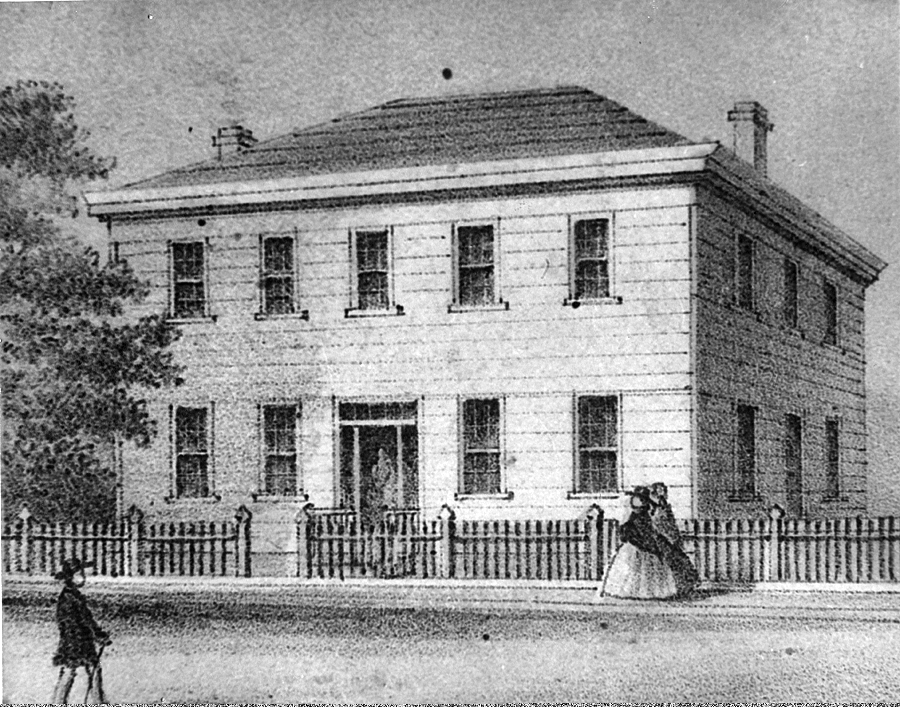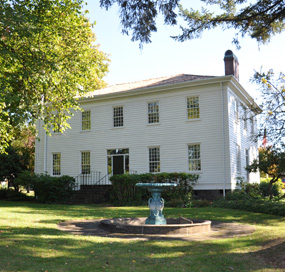In a nutshell, the story of the McLoughlin family is a story that resonates with us today in so many ways. In telling their story, we learn about love and loss, adventure and settlement, and so many other aspects of life, all against the backdrop of the fur trade in the Pacific Northwest. To be inside their home, learning about their family and the important roles they played in shaping the region in the 19th century, is incredibly powerful.

The McLoughlin House as it appeared in 1858. (NPS Photo)
In 1825, Dr. John McLoughlin established Fort Vancouver on behalf of the Hudson's Bay Company (HBC). Located on the north bank of the Columbia River in what is now Vancouver, Washington, over the next two decades this fort became the central hub in the Company's fur trade operations in the Northwest. From there, supplies were distributed to a network of other forts, which in turn sent their furs to Fort Vancouver for export to Europe.
McLoughlin first became interested in the future location of Oregon City, near the Willamette Falls, in 1829. In that year, he claimed land for the Hudson's Bay Company from the falls to the Clackamas River. he envisioned a company town at the site, and built three log cabins for HBC employees on an island near the falls. However, the cabins were promptly burned by local Native people, who were long accustomed to exclusive use of the area.
In the late 1830s and 1840s, McLoughlin began to build other structures in Oregon City in an attempt to cement his claim to the area as more and more Americans arrived and settled there. In 1845, McLoughlin was forced to resign from the Hudson's Bay Company. He paid the HBC $20,000 for the Oregon City land claim and placed it in his name. He then had a spacious home constructed for his family, now known as the McLoughlin House.
Here, McLoughlin lived with his wife, Marguerite. His daughter, Eloisa, and her family joined them in 1846. McLoughlin became an American citizen, and a prominent member of Oregon City society. From 1851-52, he even served as the city's mayor!
In 1857, John McLoughlin died, probably in the house. Marguerite died in 1860, and the remaining family eventually moved to Portland, Oregon.

The McLoughlin House in Oregon City, as it appears today (NPS Photo)
After the McLoughlin family left, the house became a boarding and lodging house known as the Phoenix Hotel, then it became a "laundry tenement." By the 20th century, the house had fallen into disrepair. In 1909, the McLoughlin Memorial Association (MMA) was formed for the purpose of "preserving and restoring the home of Dr. John McLoughlin, the founder of Oregon City." The MMA successfully raised funds to relocate and restore the house, and is still in existence today as the partner of the National Park Service in managing the site.
In 2003, the McLoughlin House was formally added as a unit of Fort Vancouver National Historic Site, and the National Park Service took over the management of the site and associated museum collections. The house is visited by hundreds of visitors annually, and is visited by many local schoolchildren on field trips, as they learn about the history of the Northwest. The house plays a central role in public programs, lectures, and family-friendly events.
As Fort Vancouver National Historic Site Superintendent Tracy Fortmann stated, "The McLoughlin House is a fantastic place for people of all ages, interests, and backgrounds, to learn about the history of both Oregon City and the Pacific Northwest. We are so pleased to be able to share this historic home in partnership with the McLoughlin Memorial Association and our partners in Oregon City."
